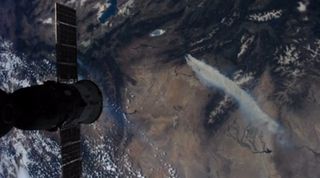
Colorado Wildfires Seen From Space in Astronaut Video

The vast scale of wildfires raging across parts of Colorado and the western U.S. has been captured on camera by astronauts on the International Space Station.
A video released by NASA today (June 28) shows huge plumes of smoke billowing up into an otherwise clear sky above the Rocky Mountains. Several fires have been burning nonstop in the region, including the out-of-control Waldo Canyon Fire that has consumed 15,517 acres (6,280 hectares) so far.
The high-definition video of the Colorado wildfires from space was taken through an Earth-facing window routinely used by the astronauts to observe their home planet.
"The crew did have some time to shoot some photos and a video of the large Colorado wildfires that are raging in the Rocky Mountains," a NASA spokesman said during the space agency's daily mission commentary. "Earth observation is one of the very useful things that's available on the unique platform of the International Space Station."
As of Wednesday (June 27), the Waldo Canyon fire was only 5 percent contained and had forced the evacuation of at least 32,000 people, NASA officials said. NASA has been keeping a close watch on the Colorado wildfires with satellite observations in addition to the sightings by space station astronauts.
The International Space Station is currently home to six astronauts: Three Russians, two Americans and one Dutch spaceflyer. Three of the astronauts are due to return home Sunday (July 1) aboard a Russian Soyuz space capsule. The landing will mark the end of a months-long stay in orbit for the station crew.
The returning astronauts are Don Pettit of NASA, Andre Kuipers of the European Space Agency, and Russian cosmonaut Oleg Kononenko, who currently serves as the station's Expedition 31 commander. The trio will be replaced by three new crewmembers scheduled to launch later in July.
Sign up for the Live Science daily newsletter now
Get the world’s most fascinating discoveries delivered straight to your inbox.
This story was provided by SPACE.com, a sister site to LiveScience. You can follow SPACE.com Managing Editor Tariq Malik on Twitter @tariqjmalik. We're also on Facebook & Google+.

Tariq is the editor-in-chief of Live Science's sister site Space.com. He joined the team in 2001 as a staff writer, and later editor, focusing on human spaceflight, exploration and space science. Before joining Space.com, Tariq was a staff reporter for The Los Angeles Times, covering education and city beats in La Habra, Fullerton and Huntington Beach. He is also an Eagle Scout (yes, he has the Space Exploration merit badge) and went to Space Camp four times. He has journalism degrees from the University of Southern California and New York University.
